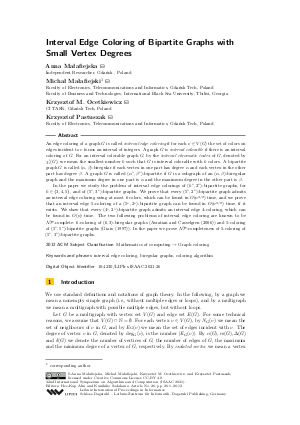Interval Edge Coloring of Bipartite Graphs with Small Vertex Degrees
Authors Anna Małafiejska, Michał Małafiejski, Krzysztof M. Ocetkiewicz, Krzysztof Pastuszak
-
Part of:
Volume:
32nd International Symposium on Algorithms and Computation (ISAAC 2021)
Part of: Series: Leibniz International Proceedings in Informatics (LIPIcs)
Part of: Conference: International Symposium on Algorithms and Computation (ISAAC) - License:
 Creative Commons Attribution 4.0 International license
Creative Commons Attribution 4.0 International license
- Publication Date: 2021-11-30
File

PDF
LIPIcs.ISAAC.2021.26.pdf
- Filesize: 0.68 MB
- 12 pages
Document Identifiers
Subject Classification
ACM Subject Classification
- Mathematics of computing → Graph coloring
Keywords
- interval edge coloring
- biregular graphs
- coloring algorithm
Metrics
- Access Statistics
-
Total Accesses (updated on a weekly basis)
0Document
0Metadata
Abstract
An edge coloring of a graph G is called interval edge coloring if for each v ∈ V(G) the set of colors on edges incident to v forms an interval of integers. A graph G is interval colorable if there is an interval coloring of G. For an interval colorable graph G, by the interval chromatic index of G, denoted by χ'_i(G), we mean the smallest number k such that G is interval colorable with k colors. A bipartite graph G is called (α,β)-biregular if each vertex in one part has degree α and each vertex in the other part has degree β. A graph G is called (α*,β*)-bipartite if G is a subgraph of an (α,β)-biregular graph and the maximum degree in one part is α and the maximum degree in the other part is β.
In the paper we study the problem of interval edge colorings of (k*,2*)-bipartite graphs, for k ∈ {3,4,5}, and of (5*,3*)-bipartite graphs. We prove that every (5*,2*)-bipartite graph admits an interval edge coloring using at most 6 colors, which can be found in O(n^{3/2}) time, and we prove that an interval edge 5-coloring of a (5*,2*)-bipartite graph can be found in O(n^{3/2}) time, if it exists. We show that every (4^*,2^*)-bipartite graph admits an interval edge 4-coloring, which can be found in O(n) time. The two following problems of interval edge coloring are known to be NP-complete: 6-coloring of (6,3)-biregular graphs (Asratian and Casselgren (2006)) and 5-coloring of (5*,5*)-bipartite graphs (Giaro (1997)). In the paper we prove NP-completeness of 5-coloring of (5*,3*)-bipartite graphs.
Cite As Get BibTex
Anna Małafiejska, Michał Małafiejski, Krzysztof M. Ocetkiewicz, and Krzysztof Pastuszak. Interval Edge Coloring of Bipartite Graphs with Small Vertex Degrees. In 32nd International Symposium on Algorithms and Computation (ISAAC 2021). Leibniz International Proceedings in Informatics (LIPIcs), Volume 212, pp. 26:1-26:12, Schloss Dagstuhl – Leibniz-Zentrum für Informatik (2021)
https://doi.org/10.4230/LIPIcs.ISAAC.2021.26
BibTex
@InProceedings{malafiejska_et_al:LIPIcs.ISAAC.2021.26,
author = {Ma{\l}afiejska, Anna and Ma{\l}afiejski, Micha{\l} and Ocetkiewicz, Krzysztof M. and Pastuszak, Krzysztof},
title = {{Interval Edge Coloring of Bipartite Graphs with Small Vertex Degrees}},
booktitle = {32nd International Symposium on Algorithms and Computation (ISAAC 2021)},
pages = {26:1--26:12},
series = {Leibniz International Proceedings in Informatics (LIPIcs)},
ISBN = {978-3-95977-214-3},
ISSN = {1868-8969},
year = {2021},
volume = {212},
editor = {Ahn, Hee-Kap and Sadakane, Kunihiko},
publisher = {Schloss Dagstuhl -- Leibniz-Zentrum f{\"u}r Informatik},
address = {Dagstuhl, Germany},
URL = {https://drops.dagstuhl.de/entities/document/10.4230/LIPIcs.ISAAC.2021.26},
URN = {urn:nbn:de:0030-drops-154596},
doi = {10.4230/LIPIcs.ISAAC.2021.26},
annote = {Keywords: interval edge coloring, biregular graphs, coloring algorithm}
}
Author Details
- Faculty of Electronics, Telecommunications and Informatics, Gdańsk Tech, Poland
- Faculty of Business and Technologies, International Black Sea University, Tbilisi, Georgia
References
- A.S. Asratian and C.J. Casselgren. On interval edge colorings of (α, β)-biregular bipartite graphs. Discret. Math., 307:1951-1956, 2006. URL: https://doi.org/10.1016/j.disc.2006.11.001.
-
A.S. Asratian and R.R. Kamalian. Interval coloring of the edges of a multigraph (in Russian). Appl. Math., 5:25-34, 1987.

- A.S. Asratian and R.R. Kamalian. Investigation of interval edge-colorings of graphs. J. Combin. Theory Ser. B, 62:34-43, 1994. URL: https://doi.org/10.1006/jctb.1994.1053.
- C.J. Casselgren and B. Toft. On Interval Edge Colorings of Biregular Bipartite Graphs with Small Vertex Degrees. J. Graph Theory, 80:83-97, 2015. URL: https://doi.org/10.1002/jgt.21841.
- R. Cole, K. Ost, and S. Schirra. Edge-coloring bipartite multigraphs in O(Elog D) time. Combinatorica, 21:5-12, 2001. URL: https://doi.org/10.1007/s004930170002.
- G.Cornuéjols. General factors of graphs. J. Combin. Theory Ser. B, 45:185-198, 1988. URL: https://doi.org/10.1016/0095-8956(88)90068-8.
-
K. Giaro. The complexity of consecutive Δ-coloring of bipartite graphs: 4 is easy, 5 is hard. Ars Combin., 47:287-298, 1997.

-
K. Giaro and M. Kubale. Consecutive edge-colorings of complete and incomplete Cartesian products of graphs. Congr. Numer., 128:143-149, 1997.

- K. Giaro and M. Kubale. Compact scheduling of zero–one time operations in multi-stage systems. Discret. Appl. Math., 145:95-103, 2004. URL: https://doi.org/10.1016/j.dam.2003.09.010.
-
K. Giaro, M. Kubale, and M. Malafiejski. Compact Scheduling In Open Shop with Zero-One Time Operations. INFOR: Information Systems and Operational Research, 37:37-47, 1999.

-
H.M. Hansen. Skemalægning med henblik påminimering af ventetid (in Danish). M.Sc. Thesis, University of Odense, 1992.

-
D. Hanson and C.O.M. Loten. A lower bound for Interval colouring bi-regular bipartite graphs. Bull. ICA, 18:69-74, 1996.

-
D. Hanson, C.O.M. Loten, and B. Toft. On interval coloring of biregular bipartite graphs. Ars Combin., 50:23-32, 1998.

-
R.R. Kamalian. Interval colorings of complete bipartite graphs and trees (in Russian). Comp. Cen. of Acad. Sci. of Armenian SSR (Preprint), 1989.

-
R.R. Kamalian. Interval edge-colorings of graphs. Ph.D. Thesis, Novosibirsk State University, 1990.

- H.H. Khachatrian and P. Petrosyan. Interval Non-edge-Colorable Bipartite Graphs and Multigraphs. J. Graph Theory, 76:200-216, 2014. URL: https://doi.org/10.1002/jgt.21759.
- L. Lovász. The factorization of graphs. II. Acta Math. Acad. Sci. Hungar., 23:223-246, 1972. URL: https://doi.org/10.1007/BF01889919.
- S. Micali and V.V. Vazirani. An O(√|V| ⋅ |E|) algorithm for finding maximum matching in general graphs. Proc. of 21st FOCS, pages 17-27, 1980. URL: https://doi.org/10.1109/SFCS.1980.12.
-
S.V. Sevastjanov. Interval colorability of the edges of a bipartite graph (in Russian). Metody Diskretnogo Analiza, 50:61-72, 1990.

